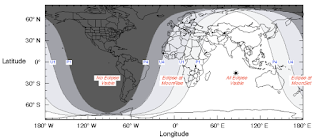
Source : http://www.mutiarapublic.com
This event becomes very interesting if observed, especially if we can record or immortalize it. But do not forget!, when the eclipse occurs, either the eclipse of the Moon or the Sun, is devoted to doing the eclipse prayer.
Then how the procedure of the eclipse prayer?. In the book of "Zaadul Ma'ad", the work of Ibn al-Qayyim is explained about the procedure of performing the eclipse prayer (Qayyim 1438: 349-356):
1. Intend in the heart and should not be mentioned because mentioning the intention does not include in the guidance of the Prophet Muhammad (Sunnah/Hadeeth) and the Prophet also never taught him intentions on certain prayers to his companions.
2. Takbiratul ihram is doing Takbir as usual prayer.
3. Read the Iftitah and Ta'awudz, then read the Al-Fatihah and read a long Surah (like the Al Baqarah) while being stitched (hardened voice, not soft) as contained in the hadeeth of A'ishah:
جهر النبى - صلى الله عليه وسلم - فى صلاة الخسوف بقراءته
"The Prophet annihilated his reading during the eclipse prayer." (Narrated by Bukhari no 1065 and Muslim 901)4. Then doing Ruku' while extending it.
5. Then rise from Ruku '(I'tidal) while saying "Sami' Allah li Man Hamidah, Rabbana wa Laka al-Hamd"
6. After this I'tidal did not directly prostrate, but continued by reading Al-Fatihah and long Surah again. This second stand is shorter than the first.
7. Then doing Ruku' again (second Ruku') which length is shorter than Ruku' before.
8. Then rise from ruku' (I'tidal) again.
9. Then prostrate as long as Ruku', then sit between two prostrations and then bow down again.
10. Then rose from prostration and worked on the second raka'at as the first raka'at only the reading and the movements are shorter than before.
11. Tasyahud.
12. Greetings (doing Salam).
13. The priest then gives a sermon to the congregation that contains the suggestion for dhikr, praying, alms, and freeing slaves.













